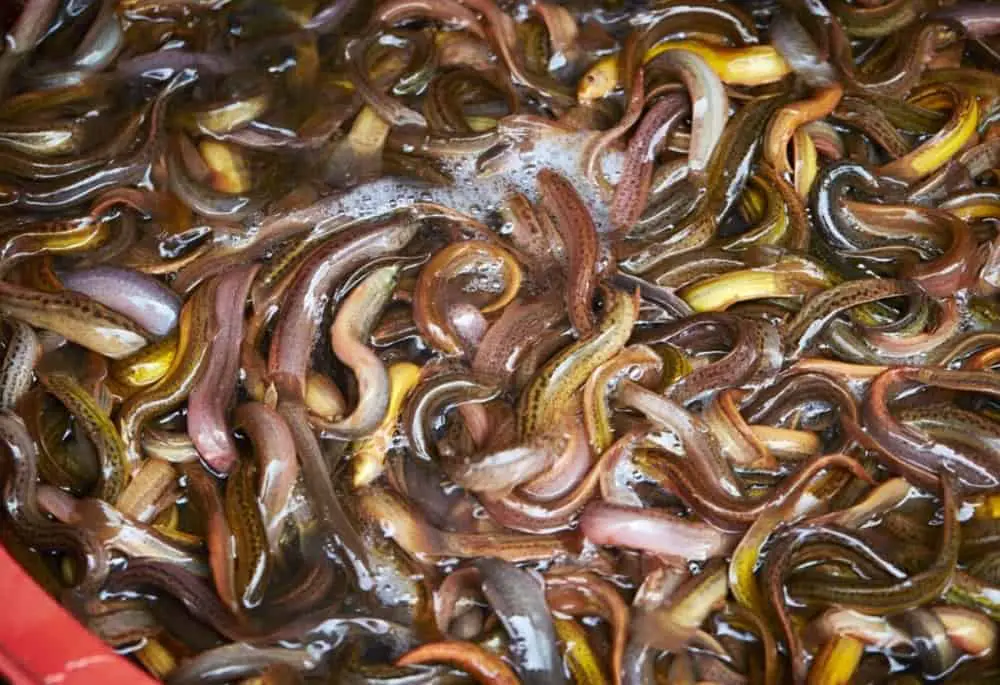Loaches are a family of freshwater bottom-dwellers. They make a popular alternative to nocturnal catfish in domestic freshwater aquariums, as they are generally more active during daytime hours.
Loaches are known for their lively personalities and interesting patterns and coloring. Whilst they are difficult to breed in a domestic environment, they are relatively easy to look after.

If you are interested in adding loaches to your home aquarium, or you want to know more about this fun species of fish, keep reading! We have put together some information about their appearance, behavioural traits, diet, tank requirements and more.
Species Summary
Loaches are found in the rivers and streams of tropical and temperate climates, such as Pakistan, China, Japan, Bourneo, Indonesia and Sumatra.
They live in fast flowing water with minimal plant life, and spend a lot of time using their whiskers to feel along the river beds for worms and insect larvae to eat. They live in communities and are quite friendly and playful.
Care Guide
Tank Size
The size of tank you need varies greatly depending on the type of loach you have chosen, as they grow to different sizes. You will also need to consider the size of the community you are creating- the more fish you have the more space you will need to provide them to keep them healthy and happy.
Whichever variety of loach you choose, you will need a tight lid as they are known to leap!
Tank Mates
The best tank mates for loaches are other loaches!
If you do plan on housing them with different species, be aware that loaches can show aggression towards members of other species. This aggression can involve biting, so ensure any tank mates you choose are robust fish and not too timid.
The biggest barriers to tank makes getting along are territory disputes and competition for food. Try and house bottom-dwellers like roaches with fish that spend most of their time swimming in the middle and upper levels of the tank.
Plan the mealtimes and delivery of food carefully to avoid creating a feeding frenzy. Make sure each fish can safely reach their food without having to bully or fight other fish.
Same Species Tanks
Loaches live in large schools in the wild and are happiest when in a community. You should aim to have at least three loaches in your tank, but schools of six or more are often very successful in a domestic aquarium.
Water Parameters
The good thing about loaches is that they should be happy and healthy in the average conditions of a freshwater domestic aquarium. Their ideal water temperature is around 72 degrees fahrenheit.
The PH level of the water should be neutral to slightly acidic, anywhere between 6.0 and 8.0. The water hardness should be within 3 and 10 KH which is quite a large range.
The natural habitat of the loach is an oxygen rich environment of fast-flowing rivers. Once they are settled in a tank they can be quite sensitive to slight changes in composition of the water, so you will need to perform regular water changes and ensure you have a good quality water filter. They would prefer a stronger water pump to replicate a fast flowing river.
What To Put In Their Tank
Whilst loaches are not nocturnal like catfish, they are most active at dawn and dusk and will rest during the brightest parts of the day. To get the most out of this species you may want to consider subdued lighting conditions to mimic dawn and dusk and encourage activity.
We recommend using a fine sand for the substrate level. Loaches like to dig around a lot with their long snouts to search for food, and gravel could scratch them.
Like many bottom-dwellers, loaches like to hide when they are inactive. To keep them happy and stop them from getting stressed you will need to provide plenty of hiding spaces. Artificial caves, smooth rocks and even driftwood make good options for this, even though their natural habitat would not have driftwood.
Their natural habitat would have little to no plant life, so you don’t need to worry about providing vegetation. They would likely appreciate some smooth pebbles for the variety of texture.
Common Diseases
Loaches are particularly prone to Ich – a parasite that causes white spots on the skin. This is caused by a dirty tank so make sure the water is changed frequently and the filter is working.
Stress can make your fish more likely to become ill, which is why adequate hiding spaces and suitable tank mates are so important.
A nutrient rich diet can also help to keep your fish healthy and stop them from becoming unwell.
Food & Diet
Loaches are omnivorous so would appreciate a diet of live, frozen and dried food, supplemented with some greens like cucumber. There are some varieties of loach that eat molluscs, but these tend to be the more aggressive types of loach which are not as suited to domestic tanks. Smaller types of loach will also eat algae and microorganisms.
Loaches enjoy a varied diet and will get bored of eating the same thing every day. It is best to switch it up and feed them different types of food on different days. You should feed them enough food to keep them eating for no longer than two minutes, and feed them like this once or twice a day.
Lifespan
The lifespan of loaches varies between the different types, but on average they should live for somewhere between 7 and 10 years depending on their conditions.
You can maximise their lifespan by providing them with plenty of space, a well-maintained tank, the right tank mates, a good quality diet, and keeping their stress levels as low as possible.
Appearance
The specific appearance and coloring varies greatly spending on the variation of loach you have chosen. They can be spotted, striped, or mottled, with vibrant colors or dull browns and grays.
One of the features that makes loaches so popular with aquarists is that their coloring changes as they grow. Owners enjoy tracking the changes in coloring and pattern as their fish mature.
Loaches also change their colors as they interact with each other, sometimes becoming less vibrant. This is a temporary change and happens when they are trying to establish dominance in the social hierarchy.
The majority of loaches have small, narrow and elongated bodies. Their bodies are covered in very small scales. They have between 3 and five whiskers around their mouths which help them to feel along the bottom of the river or the tank for food.
Size
The size will depend on the type of loach. The smallest are known to grow to 2 inches long, and the biggest up to 2 feet long. The average length for most loach types in a domestic tank is around 6 inches.
Behaviour & Temperament
Loaches have a friendly temperament with lively personalities, and they are known to interact with their human owners.
Many beginner aquarists will worry about their loaches as they spend a lot of time lying on their side at the bottom of the tank, but this is normal. As long as they are not breathing particularly heavily it is nothing to be concerned about.
Most loaches are peaceful but some of the larger variations can be more aggressive or boisterous and will pick on smaller fish in the tank.
Breeding
Loaches are considered to be very difficult to breed in a domestic aquarium, mainly because it is hard to identify a bonded pair who are sexually mature and ready to breed.
If you do find a pair to breed, they need to be moved to a separate tank for the female to lay the eggs. As soon as the eggs are fertilized by the male, the parents need to be removed and returned to the main tank as they are very likely to eat the eggs during the incubation period, or the smallfry when they hatch.
The smallfry can be fed with powdered food and then small brine shrimp. Successfully raising smallfry in an aquarium is extremely difficult and many will die.
Gender Differences: Male vs Female
It is very difficult to differentiate between male and female loaches which makes it difficult to identify a bonded pair for mating. Slight color variations between sexes may be present in different types of loaches.
In general, female loaches are usually slightly plumper than the males- especially around spawning season. Females have straight tips on their tails whereas males have a curve on the tip of their tail.
Fun Facts
- Loaches have a retractable spine below the eye which extends when they are stressed – be careful when removing them from the tank!
- If your loaches are unhappy they will make a clicking noise.








